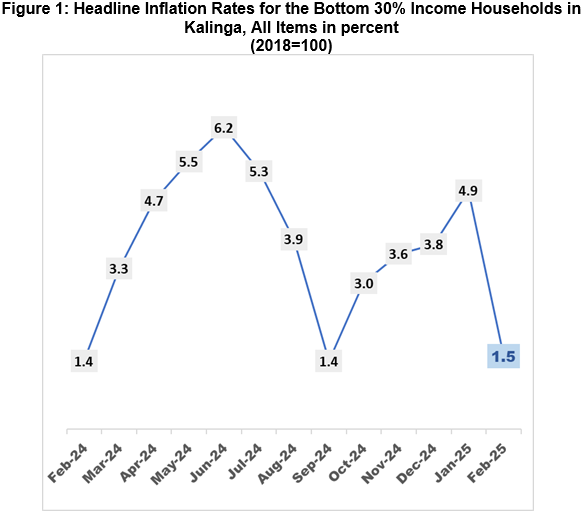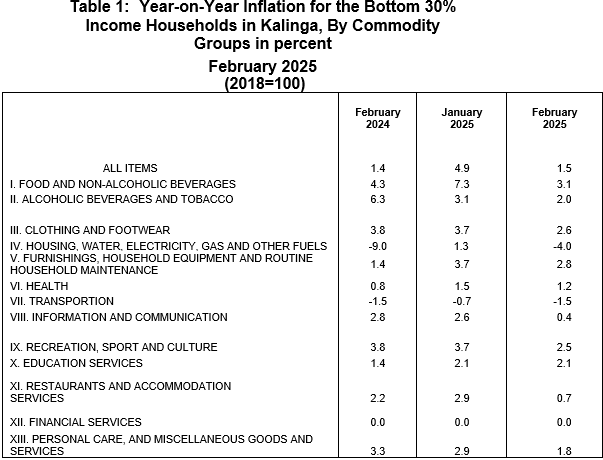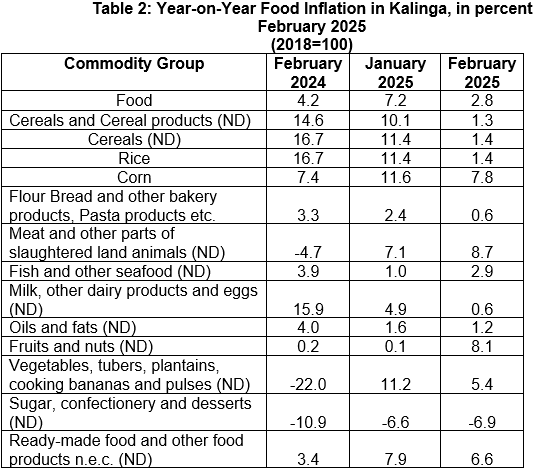The Headline Inflation rate for the Bottom 30 percent Income Households in Kalinga goes down to 1.5 percent in February 2025, from 4.9 percent in January 2025. In February 2024, inflation rate was observed at 1.4 percent.


Main Drivers to the Upward Trend of the Headline Inflation
The decrease in the overall inflation for the Bottom 30% Income Households in February 2025 was primarily brought about by the monthly decrease of the following items:
a. Foods and non-alcoholic beverages with 3.1 percent from 7.3 percent;
b. Clothing and footwear, 2.6 percent from 3.7 percent;
c. Alcoholic beverages and tobacco, 2.0 percent from 3.1 percent;
d. Furnishings, household equipment and routine household maintenance, 2.8 percent from 3.7 percent;
e. Personal care, goods and miscellaneous services, 1.8 percent from 2.9 percent;
f. Health, 1.2 percent from 1.5 percent
g. Restaurants and accommodation services with 0.7 percent from 2.9 percent,
h. Information and communication, 0.4 percent from 2.6 percent;
i. Housing, water, electricity, gas and other fuels at -4.0 percent from 1.3 percent and,
j. Transportation, -1.5 percent from -0.7 percent.
Meanwhile, there is no change in the commodity group of Financial Services.
Main Contributors to the Headline Inflation
The top three (3) commodity groups contributing to the February 2025 overall inflation was the following:
1. Food and non- alcoholic beverages;
2. Restaurants and accommodation services, and
3. Furnishings, household equipment and routine household maintenance

Food inflation
Food inflation at the provincial level for the bottom 30% income household decreased to 2.8 percent in February 2025 from 7.2 percent in the previous month. In February 2024, food inflation was higher at 4.2 percent.
Main Drivers to the Downward Trend of Food Inflation
The deceleration of food inflation in February 2025 was primarily brought about by the following items:
- Ready-made food and other food products n.e.c. with 6.6 percent from 7.9 percent;
- Vegetables, tubers, plantains, cooking bananas and pulses with 5.4 percent from 11.2 percent;
- Cereals and cereal products with 1.3 percent from 10.1 percent;
- Oil and fats with 1.2 percent from 1.6 percent;
- Milk, other dairy products and eggs with 0.6 percent from 4.9 percent;
- Flour and other bakery products with 0.6 percent from 2.4 percent;
- Sugar, confectionery and desserts with -6.9 percent from 6.6 percent.
On the other hand, the following commodity groups registered higher inflation rates during the month:
- Meat and other parts of slaughtered land animals with 8.7 percent from 7.1 percent;
- Fruits and nuts with 8.1 percent from 0.1 percent and,
- Fish and other seafood with 2.9 percent from 1.0 percent.
Main Contributors to the Food Inflation
The top three (3) food groups in terms of contribution to the food inflation during the month were the following;
- Meat and other parts of slaughtered land animals.
- Cereals and cereal products and
- Vegetables, tubers, plantains, cooking bananas and pulses
Note: CPI’s and inflation rates by region, province and selected city are posted at the PSA website (www.psa.gov.ph).
sgd.
MARIBEL M. DALAYDAY
Chief Statistical Specialist

